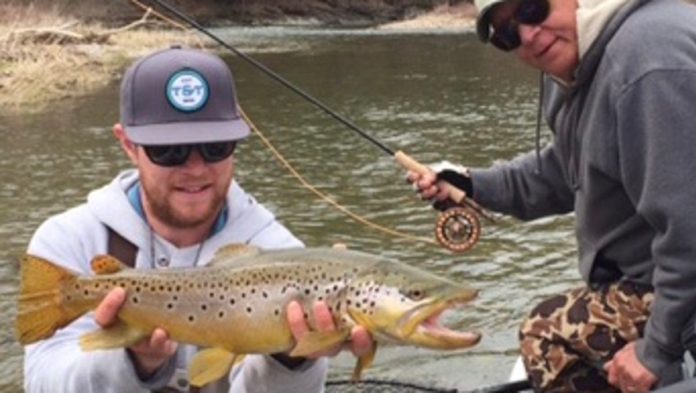For two generations, Worcester’s downtown had been blessed by the presence of two community-influencing fly fishing shops. The first, of course, long before the likes of Orvis and Cabelas, was Paul Kukonen’s Green Street shop, which even the likes of Boston Red Sox immortal, Ted Williams, patronized often.
Kukonen put on popular fishing shows from our Auditorium to our sportsman’s clubs, told fabulous bourbon-augmented stories – and found plenty time to make pioneering fishing films and even hunt with his bird dogs. On the best days, the shop would open late or close early. Paul was an irascible rascal far ahead of his time. I’ll never forget the piece of real polar bear hair that he gave me to tie my first streamer flies when I was still a student at Classical High.
After Kukonen passed away, Jim Bender’s Lower Forty Outfitters Madison Street shop, located where the new WooSox stadium sits, proved an even more popular magnet, attracting everyone who was serious about the art of fly fishing. The great Felix Stolulonis, Worcester’s pioneering Atlantic salmon fisherman, found his second home at Bender’s hideaway.
There was no quality gear, essential fly, or vitally important local fishing advice that Bender didn’t carry – or couldn’t get to share. Bender fixed rods and reels, gave seminars, put out informative reports of river and mayfly hatching conditions, and even led exotic fishing trips with world-class guides. With Bender’s property sale and retirement, there’s been a vacuum that no one has yet filled in our city.
Bender, now happily retired in Harwich, shared thoughts and, as always, a few fishing tips to pass on to his many friends here around Worcester. He clearly left part of his heart in our city and misses the many meaningful connections he made with local angling friends.
“I’ve been spreading my time between Cape Cod’s south-facing tidal estuaries in search of surface schoolie action and the Chatham shellfish flats – enjoying a bit of success at both. I’m angling exclusively from kayaks these days – and loving it.
“Usually I’m on the water before 5 a.m., and at 71, I’ve usually got about 3 to 4 hours in me. So far this season, I’ve caught nothing larger than 27-inchers, but I expect to see larger stripers arriving within a week.”
As for killer fly selection tips, Bender shares, “For the last four years, I’ve been using a fly called the Pole Dancer, which is a surface offering with plenty enticing action.” If you fly fish for stripers, I’d suggest you pack a bunch of those in your fly box as soon as possible.
“On the way to a medical appointment, I stopped by Worcester’s old Canal District neighborhood,” Bender said. “Worcester should be very proud of not only its new ball club but the entire surrounding development. I couldn’t pass up the opportunity to stop by Golemo’s Market at 43 Millbury Street for some of their irresistible garlic-smoked kielbasa. If you’ve never had it, you’re missing out.”
Bender did pay a personal price for being dependably in his shop – especially at the hottest fishing times of the year.
“I owned the fly-fishing shop for 27 years, and the time I spent there never felt like work, though now I don’t have to live and fish vicariously through my customers’ successes anymore,” he said.
Bender is one of our few fishing historians, having rubbed shoulders with just about all of our greatest fly fishermen.
“We lost two great fly anglers within the last few months. Lenny Renauld of Sterling traveled throughout the US and Canada with me fishing most of our iconic waters during the last 50 years. And Jack Varley of Princeton, who was a frequent flyer of Harrison Anglers and a master of the Deerfield River. He and I fished Belize many times together. Both were dedicated to all that’s wonderful about fly fishing and will be missed by our angling community.”
Let’s hope there’s room for yet another fly shop in the Canal District to bring back the magic that Paul and Jim shared with us.
Keep an eye out for right whales
While waiting for the black sea bass season to start, lobstermen, including my son Matt and me, waited to see whether we could put out our pots this weekend. Our collective activities – both commercial and recreational – have been an additional threat for the survival of the 400 or so right whales trying to survive the gauntlet of dangers they’re daily subjected to.
Right whales most often swim near shore with a vulnerably slow pace. Tending to float when killed, they were the “right” whale to commercially pursue – even as they neared extinction. Aggressively hunted, their population plunged from about 21,000 to fewer than 100 by the 1920s. Whaling for them wasn’t banned until 1935. For a while, there was hope.
By 2010, their population increased to 483 – then commercial factors at sea reversed that progress. Efficient gear for lobsters, snow crab, halibut, flounder and cod proved lethal. An average of about a hundred right whales each year got entangled in it – some fatally.
It’s estimated that fully 83% of all our right whales have been entangled by ropes at least once in their lifetime. The heavy gear drags them down, tires them out, limits their feeding and reproduction. Often the ropes cut them, causing infections, and even the severing of fins and tails. Entanglements too often kill them.
Severe collisions with vessels and deep cuts of propellers is the second leading cause of their mortality – usually when boats are traveling too fast. Mandated reduction in speeds can help them greatly – if boaters will adhere to the regulations. Swimming usually about 6 miles per hour, usually near the water’s surface, their dark bodies are often unseen. They are also dark in color and lack a dorsal fin, making them very difficult to spot.
Thankfully, almost all of them have left our waters as of this week – and as of May 14, we’ve been able to safely set out our lobster pots. For the first year ever, Matt and I had the first pots out on the water ahead of everyone else. I hope to be pulling pots next week – and avoiding the $59 per-pound charge for lobster meat that shockingly faces us in local fish markets.
When we pulled into the Sandwich Marina after additionally taking a cooler-full of mackerel from just east of the Canal near the CC bell buoy, we were met by Marine Fisheries people checking our haul. I was surprised to hear that although many tautog, flounder, mackerel and haddock had been brought in that day from Cape Cod Bay, not one legal-size striper had been taken or kept. I would have thought that impossible in previous years.
The temperatures were right at 57-degrees, and even common terns had come back to nest and hunt for tiny baitfish – but only under-size schoolies had been brought to net. You have to believe that this coming week, the striper fishing is about to explode with big schools running through the Canal.
Contact Mark Blazis at markblazissafaris@gmail.com.
Credit: Source link































